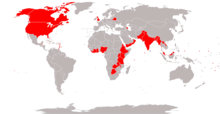
Back الفوز للأكثر أصواتا Arabic Escrutiniu mayoritariu uninominal AST Асноўнае галасаваньне з адным пераможцам BE-X-OLD फर्स्ट पास्ट द पोस्ट Bihari ফার্স্ট-পাস্ট-দ্য-পোস্ট ভোটদান Bengali/Bangla Escrutini uninominal majoritari Catalan System etholiadol 'y cyntaf i'r felin' Welsh Escrutinio mayoritario uninominal Spanish رأیگیری نخستگزینی Persian Scrutin uninominal majoritaire à un tour French
| Part of the Politics and Economics series |
| Electoral systems |
|---|
 |
|
|

First-preference plurality (FPP)—often shortened simply to plurality—is a single-winner system of positional voting where voters mark one candidate as their favorite, and the candidate with the largest number of points (a plurality of points) is elected. It is sometimes called first-past-the-post, based on a metaphor from horse racing.[1]
In social choice theory, FPP is considered a degenerate form of ranked voting, where voters "rank" candidates, but only the first preference matters; as a result, FPP is usually implemented using a choose-one ballot, where voters mark a single bubble next to their favorite candidate.
FPP has been used to elect the British House of Commons since the Middle Ages. It is use extends to former British colonies, most notably the United States, Canada, and India. It is used as the primary form of allocating seats for legislative elections in about a third of the world's countries, mostly in the English-speaking world. It is also used to directly elect heads of states in some, although less often than the two-round system.[citation needed]
Notwithstanding its simplicity and antiquity, there are several major drawbacks to FPTP. As a winner-take-all method, it often produces disproportional results, particularly when electing members of a legislature, in the sense that political parties do not get representation according to their share of the popular vote. This usually favors the largest party and parties with strong regional support to the detriment of smaller parties without a geographically concentrated base.
Supporters of electoral reform are generally highly critical of FPTP because of this and point out other flaws, such as FPTP's vulnerability to gerrymandering which can create districts distorting representation in the legislature, the high number of wasted votes, and the chance of a majority reversal (i.e., the party winning the most votes getting fewer seats than the second-largest party and losing the election). Throughout the 20th century many countries that previously used FPTP have abandoned it in favour of other electoral systems, including the former British colonies Australia, and New Zealand (these nations now use IRV + STV and MMP, respectively).
Some countries use FPTP alongside proportional representation (PR) in a parallel voting system, or in compensatory mixed systems, e.g. as part of mixed-member proportional representation.
- ^ "First past the post". nzhistory.govt.nz. Ministry for Culture and Heritage. 13 January 2016. Archived from the original on 24 May 2022. Retrieved 25 May 2022.
© MMXXIII Rich X Search. We shall prevail. All rights reserved. Rich X Search